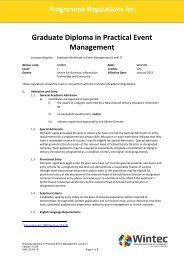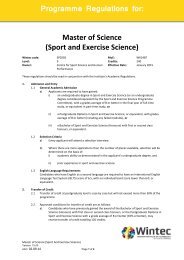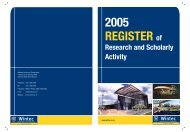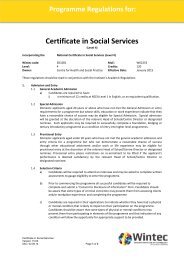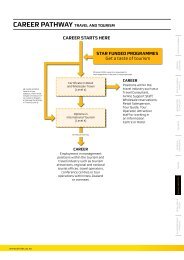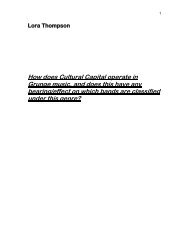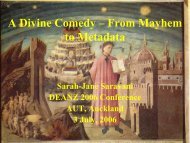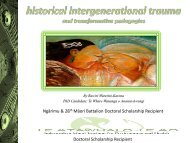aotearoa liberators - Wintec Research Archive
aotearoa liberators - Wintec Research Archive
aotearoa liberators - Wintec Research Archive
- No tags were found...
Create successful ePaper yourself
Turn your PDF publications into a flip-book with our unique Google optimized e-Paper software.
artistakaterina matairaAhora, Ralph a sus 76 años es uno de los principalesartistas de Nueva Zelanda con reputacióntanto internacional como nacional. Su obra es unade las adquisiciones mas valuadas en muchas galeríasneozelandesas y en colecciones privadas.De ascendencia maori, él creció en una remota villajunto al mar en la costa oriental de la isla del nortede Nueva Zelanda. La villa se llama Mitimiti, quesignifica ‘lamer’, nombre que recuerda lo amargode las batallas tribales cuando los Ngapuhi cayeronsobre el pequeño asentamiento y masacraron a sugente. En la playa esta en pie una roca grande yprominente en la cual parte de la batalla ocurrió.Se dice que los victoriosos Ngapuhi lamieron lasangre derramada de sus víctimas en esa roca.Este horrendo evento, dicho y vuelto a decir porgeneraciones, pudo muy bien haber influenciadoel total rechazo a la violencia a la generación deRalph, especialmente la violencia justificada porsucesivos gobiernos del mundo contra la humanidady el medio ambiente.Sus pinturas de protesta comenzaron cuando estudiabaen la Escuela central de Arte en Londres.Fue durante el período de la guerra fría contraRusia. El gobierno de EEUU había persuadido yconsiguió un arreglo con el gobierno británico parapermitir la construcción de bases para misiles en elReino Unido, de donde los misiles Polaris podíanser lanzados contra un posible ataque ruso. Esefue un volátil período de marchas de protesta yde una serie de expresiones públicas de repudioa las políticas internacionales. En el lienzo, Ralphcapturó la furia, el miedo y la anticipada violenciade la inminente guerra en su serie Polaris de granformato.Nacido en la fe católica de Roma y educado comointerno en una escuela católica-romana, no debesorprender que Ralph use el crucifijo como símbolorecurrente de expresión contra la guerra y lasvidas sacrificadas de hombres y mujeres jóvenesen batallas. Es más, uno de sus hermanos muriópeleando y su cuerpo quedó en Sangrio, Italia.Después de visitar el cementerio en Sangrio ycontemplar la tumba de su hermano, realizó unaserie de pinturas llamadas “la Serie de Sangrio”,estos trabajos están pintados en sombríos tonosgrises y reflejan las líneas angulares y encrestadastexturas de las tumbas. El sentimiento de estaobra es de profunda tristeza.La intrusión de los Estados Unidos en los asuntosdel Medio Oriente también han sido alimento parael pincel de Ralph. En estas obras los colores delhumo, fuego y explosiones se combinan con palabrasy símbolos arábicos que expresan su continuaprotesta contra la guerra.En su propia tierra, Nueva Zelanda, él es igualmentefuerte en sus protestas contra acciones delgobierno que ponen en peligro el medio ambientey los recursos naturales de la nación. A su regresode sus estudios en el exterior, Ralph se asentó enPort Chalmers, Dunedin. Desde ahí defiende y protegeferozmente la vida marina que abunda en lasaguas de la Isla del Sur y la bahía en donde vive.Cuando las autoridades locales quisieron construiruna fundidora de aluminio en un sitio cercano a labahía, otra serie de trabajos inspirados en el tema,salieron a la luz.Mientras la mayor parte de su obra es de protesta,oscura y no fácil de entender, también nos habladel profundo sentimiento que Ralph tiene por lasantidad de la vida en todas sus formas.RALPH HOTEREKua 76 tau nei te pakeke o Ralph, ko ia tētahi o ngā tino tohungawhakairoiro o Aotearoa, kua horapa hoki tōna rongoki ngā tōpito o te ao. He tino taonga āna mahi ki ngā wharewhakaaturanga toi me te hunga kohi whakairoiro.I pakeke mai a Ralph i te papa kāinga ō ona tīpuna i te tahahauāuru o te Ika a Māui, o Aotearoa. Ko Mitimiti te ingoa otaua kāinga, he ingoa whakamaumahara i ngā pakanga ā-iwime te hekenga iho o Ngāpuhi ki te patu i te hapu o Ralph.Kei te onepū e tū ana tētahi toka nui, koia i tū i waenga o ngāhoariri o te pakanga. E ai ki ngā kōrero, i mitimitia e ngā toa oNgāpuhi te toto o te hunga mate i maringi ki taua toka.Nā tēnei kōrero wetiweti, koia i whakahuahuatia kia rongongā taringa o ia whakatipuranga, o ia whakatipurangi i tokomai ai i roto i a Ralph tana kore whakaae ki ngā mahi ririhaukatoa, kore rawa hoki e whakaae ki ngā mahi kōhuru i te hungatangata me te wheiao e whakaaetia ana e ngā kāwanatangao te ao.I toko tuatahi mai ēnei whakaaro ōna i āna whakairoiro i tewā i te Central School of Art o Rānana, a ia e kura ana. Koirā tewā whakatumatuma ai a Rūhia rāua ko Amerika. I whakaaetiae te kāwanatanga o Ingarangi kia whakatutū papa kurupere ngā Marikena hei kurukuru mā rātau ki ngā Rūhia inapakanga mai rātau. Koirā hoki te wā i kaha te takahi whenuame te kauwhau a te hunga kore whakaae ki terā kaupapa mengā kaupapa manene a te kāwanatanga. Ko Ralph tērā e hopuana i te pukuriri, te mataku me te wehi ki ngā pakanga i roto iāna whakairoiro. I tapaina e ia ēnei mahi ko te Polaris Series.Nā tana tipu mai pea i roto i te Hāhi Katorika i tiki atu ai aRalph i te rīpeka hei tohu auau māna mō ngā pakanga o te aome te matemate o te hunga tangata i roto i aua pakanga. Kotana tuakana tonu tētahi i hinga i te pakanga tuarua o te ao, itanumia hoki ki Sangrio, Itāria. I tae atu a Ralph ki te moengaroao tana tuakana whakamomori ai. Nā tērā ka puta hoki hewhakairoiro anō. I tapaina ēnei whakairoiro ko te SangrioSeries, e mau ana hoki i konei ko ngā tūāhua kiwikiwi, konae,kōputaputa, kōhakihaki o ngā pohatu. Mau ana ano te tinopōuri o te whatumanawa.He take whāngai anō i te taitai whakairoiro a Ralph tērā ote kuhu atu o ngā Marikena ki ngā take nui o ngā whenuaWaenga Rāwhiti. I konei ka mahi ngātahi ngā kupu tauiwi,ngā kupu Arabic me ngā tae o te kauruki, te pohu me te murao te ahi hei whakaputa i te tino kino o Ralph ki aua pakanga.I te hau kāinga, i Aotearoa, kaha anō te whakahē a Ralph i ngākaupapa tūkino i te whaiao, a ngā kaunihera. I tana hokingamai i rāwāhi i noho a Ralph ki Koputai, Otepoti. Kaha tanawhawhai kia ora tonu ngā ika me ngā mātaitai o te Waipounamume te whanga o Koputai. Nō te putanga o te kaupapawhakatū whare tahu konumohe a te kaunihera o taua takiwā,ka puta anō ngā whakairoiro whakahē a Ralph. Kīhai tauawhare i tū.He whakahē i ngā mahi tūkino a te hunga kāwanatanga tenuinga o ngā whakairoiro a Ralph. Ahakoa te pōuriuri me teuaua o te kite marama atu he aha te tikanga o ana whakairoiro,koia tērā te tino tikanga, arā, ko te tapu o te toiora o ngāmea katoa.Now 76 years old Ralph is one of the foremost artistsof New Zealand with both a national and internationalreputation. His works are a valued acquisitionin most New Zealand art galleries and manyprivate collections.Of Maori descent he grew up in a remote seasidevillage on the west coast of the North Island ofNew Zealand. The village is called Mitimiti, meaning‘to lick’, a name which recalls the bitterness oftribal battles when the Ngapuhi descended on thequiet settlement and slaughtered its people. On thebeach stands a large and prominant rock on whichpart of the battle ensued. It is said that the Ngapuhivictors licked the spilled blood of their victims fromthis rock.This horrendous event, told and retold through thegenerations, may well have influenced Ralph’stotal rejection of all violence, especially the violencecondoned by successive world governmentsagainst humanity and the environment.His protest paintings began when he was studyingat the Central School of Art in London. It was duringthe period of the cold war with Russia. The governmentof the USA had pursued and won an agreementwith the British government to permit the buildingof missile bases in the United Kingdom, fromwhich Polaris missiles could be launched against apossible attack by the Russians. That was a volatileperiod of protest marches and public expression ofstrong disagreement with government foreign policy.On canvas Ralph captured the anger, the fearand the anticipated violence of impending war inthe large works, of the Polaris Series.Born into the Roman Catholic faith and educatedin a Roman Catholic boarding school it is not surprisingthat Ralph should use the crucifix as a recurringsymbol of expression against war and thesacrificed lives of young men and women in battle.Indeed, one of his bothers was killed in action andburied in Sangrio, Italy. After visiting the cemeteryat Sangrio and contemplating his brother’s grave,a series of paintings resulted. Called the SangrioSeries, these works are painted in sombre tonesof grey and reflect the angular lines and encrustedtextures of tombstones. The mood of the works is adeep and ineffable sadness.The ongoing intrusion of America in the affairs ofthe Middle East has also been fuel for Ralph’spaintbrush. In these works the colors of smoke, fireand explosion combine with words and Arabic symbolsto express his continuing protest against war.On the home front in New Zealand he is equallystrong in his protests against the actions of localgovernment that threaten the environment andthe natural resources of the nation. On his returnfrom study abroad Ralph settled in Port Chalmers,Dunedin. He is fiercely protective of the marine lifethat abound in the waters of the South Island andthe harbour where he lives. So when the local authoritiesplanned to build an aluminum smelter on asite near the heads of the harbour another series ofworks was triggered.While most of his paintings are works of protest,are often dark and not easily understood. They infact tell us how deeply Ralph feels for the sanctityof all life.Katerina Te Heikoko Mataira, August 1 2007Hamilton/Kirikiriroa, Aotearoa/New Zealand



